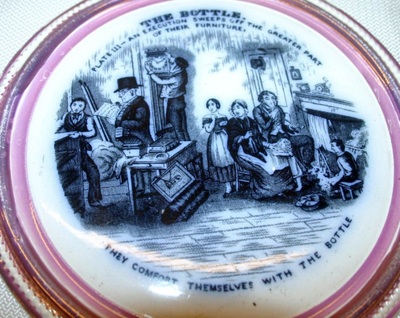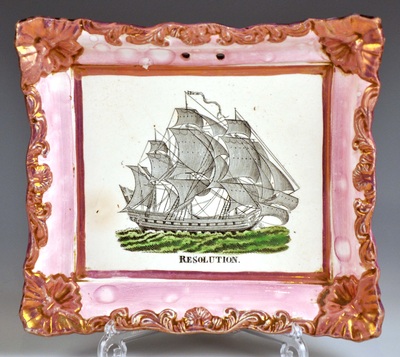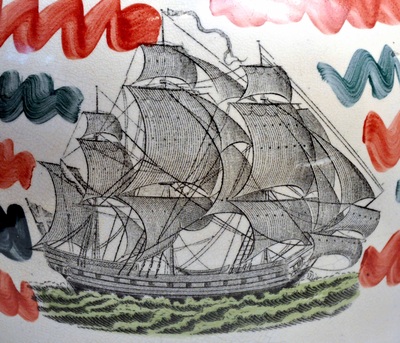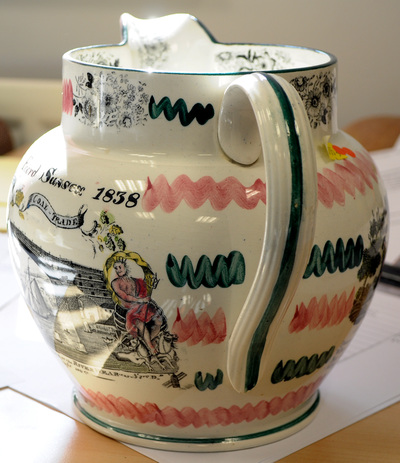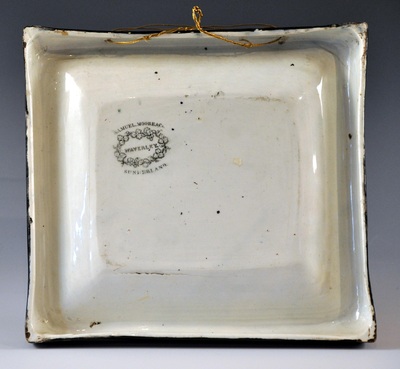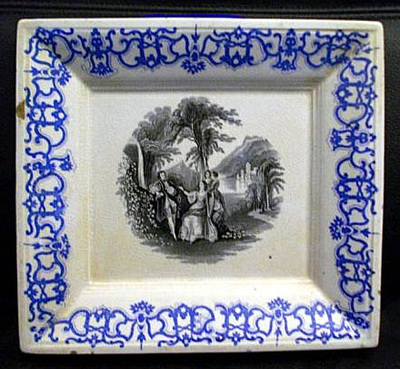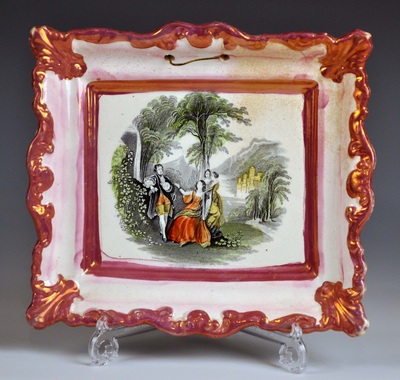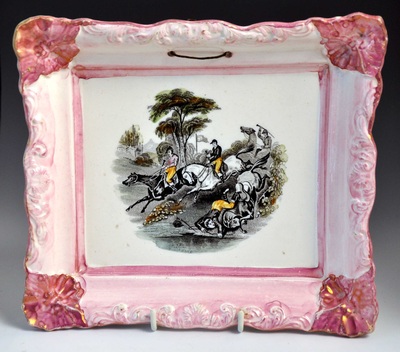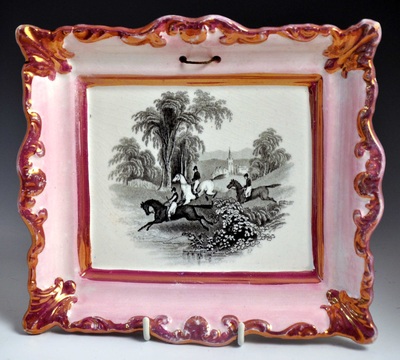|
Of all the North East potteries producing transfer-printed plaques, Moore & Co's Wear Pottery in Southwick is hard to beat. Which other pottery could match the quality of the plaque below (the best of its kind I've ever seen)? For lightly potted plaque forms, quality of decoration, and the sheer variety of transfers - series like The Bottle and Aesop's Fables - Moore takes, in my view, the gold medal. I have written before about transfers which Moore shared with the neighbouring Sunderland pottery Scott. But Moore produced many transfers that never appear on Scott wares. My guess is that these were produced earlier, in the 1840-55 period. Here's a short survey of those which appear on plaques. Cruickshank engraved The Bottle series in 1847. It's perhaps a surprise that the circular plaque on the left was produced that late, as it's a form I'd associate with the previous decade (if you are the owner, I would love better photos). The elaborate printed mark is another detail that few North Eastern potteries troubled with. Incidentally, Moore used the 'S. M & Co' mark, long after Samuel Moore's death in 1844. Although many of the ship transfers used by Moore also appear on Scott items, the transfers below appear to be exceptions. HMS Volage (images 1 & 2 below) served in the first Opium War of 1839–42, before becoming a survey ship in 1847. The Steamship Trident (images 4 & 5) was commemorated in an engraving in 1842. This would fit with an 1840s' date for the plaques below, which mostly have Moore & Co impressed marks. Below is another transfer of a ship, which appears on plaques with different titles (Commerce, Union, Resolution, Victor, Eclipse). The ship names would have been engraved on separate transfer plates - another Moore touch. The ship transfer appears untitled on jugs (see below) with distinctive decoration. One came up at Anderson & Garland recently with a dated inscription, 1838 (bottom right). This ship transfer nearly always appears on rectangular plaques with 'scalloped corners' (Ian Sharp calls them 'butterfly corners', which is perhaps better) as below. The circular plaque is the only one of its kind that I've seen with this ship transfer. Transfers titled 'Waverley' (images 1 to 6 below) and 'Chantry' (images 6 to 9) appear on unusually large rectangular plaques, which Baker dates as 1840s. They also appear on the more usual plaque forms with pink lustre. These transfers were reproduced in large numbers, relative to most of the others in this post, but to my knowledge never appear on Scott items. The next Moore series, 'Sporting', are interesting from the point of view of dating. The first three plaques below have the printed mark 'Sporting'. However, by the time the last two were produced, a pattern number '50' had been added to the printed mark. The first three plaques were likely made in the 1840s, and the last two perhaps into the 1850s. The marks belong to the plaques to their left. Note that the third appears in conjunction with the impressed mark 'Moore & Co'. Moore produced several other landscapes. The first three have the Moore & Co impress, and are typically decorated with an inner and outer frame of dark lustre. The second row have the printed mark 'Cuyp' after the Dutch painter of cows. The last plaque commemorates the 'California' gold rush of 1848. Moore produced a series of transfers of Aesop's fables, but they so rarely appear on plaques the two below are the only ones I've ever seen. They both have three marks. The left mark identifies that the designs were registered in 1853. You can see more of the series on a bowl here. To go out with a bang, here are two Moore portraits. They could be a little later than the plaques above, as the centenary of Robert Burns' birth was in 1859, and the tricentenary of William Shakespeare's birth in 1864. The transfers are very rare, but to date I haven't seen them on Scott items. So why does dating them matter? Well, the copper transfer plates from which the transfers were printed could only be in one place at a time. So I've been wondering where the transfers shared by Scott and Moore originated. It seems almost certain that it was Moore (with their track record of design innovation) who had the plates engraved. The Moore plaque below left is entirely in keeping in style with the Crimean period of c1855. What's more, the plaque has the Moore & Co impress, just like the plaques above. The confusion arises because Scott is attributed with making, I'm guessing sometime after 1860, many, many more plaques with this transfer than Moore ever did (see below right). Incidentally, since writing the blog post in 2011, I've seen several bowls with the ship transfers and a Moore impress. One came up at Bonhams recently with a hand-painted date, 1859. I've included another below. However, it has a letter under the impress, so is likely later. My guess is that there was no overlap of production of the two plaque types above. Sometime around 1860 either:
P.S. There are likely more plaques with mid-century Moore transfers to be discovered. For instance, I know of one with a Highland family, which I haven't yet managed to photograph.
0 Comments
Leave a Reply. |
AuthorStephen Smith lives in London, and is always happy to hear from other collectors. If you have an interesting collection of plaques, and are based in the UK, he will photograph them for you. Free advice given regarding selling and dispersal of a collection, or to those wishing to start one. Just get in touch... Archives
February 2022
AcknowledgementsThis website is indebted to collectors, dealers and enthusiasts who have shared their knowledge or photos. In particular: Ian Holmes, Stephen Duckworth, Dick Henrywood, Norman Lowe, Keith Lovell, Donald H Ryan, Harold Crowder, Jack and Joyce Cockerill, Myrna Schkolne, Elinor Penna, Ian Sharp, Shauna Gregg at the Sunderland Museum, Keith Bell, Martyn Edgell, and Liz Denton.
|

